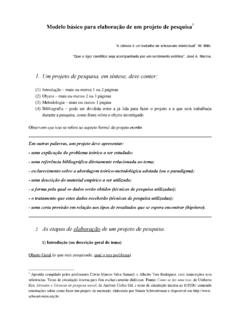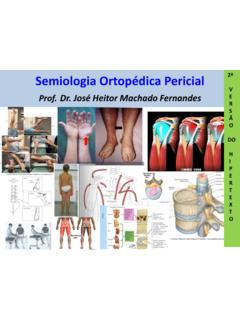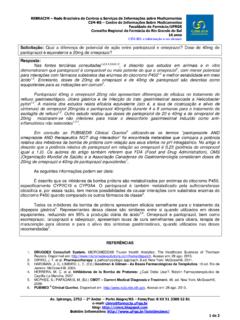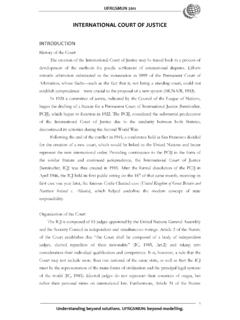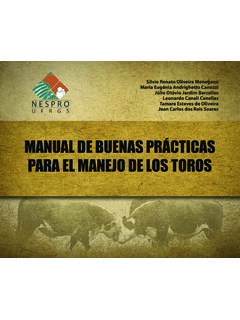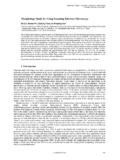Transcription of SBS and SEBS Block Copolymers as Impact Modifiers …
1 SBS and SEBS Block Copolymers as Impact Modifiers forPolypropylene CompoundsF. O. M. S. Abreu,1M. M. C. Forte,1S. A. Liberman21 UFRGS, Escola de Engenharia, Laborato rio de Materiais Polime ricos, Av. Osvaldo Aranha, 99 s702,90035 190 Porto Alegre, RS, Brazil2 Braskem , III Po lo Petroqu mico, 95853 000 Triunfo, RS, BrazilReceived 3 February 2004; accepted 23 May 2004 DOI online in Wiley InterScience ( ).ABSTRACT:Blends of polypropylene (PP) and thermo-plastic elastomers (TPE), namely SBS (styrene-butadiene-styrene) and SEBS (styrene-ethylene/1-butene-styrene) Block Copolymers , were prepared to evaluate the effective-ness of the TPE type as an Impact modifier for PP andinfluence of the concentration of elastomer on the polymerproperties. polypropylene homopolymer (PP-H) and ethyl-ene propylene random copolymer (PP-R) were evaluated asthe PP matrix.
2 Results showed that TPEs had a nucleatingeffect that caused the PP crystallization temperature to in-crease, with SBS being more effective than SEBS. Microstruc-ture characterization tests showed that in most cases PP/SEBS blends showed the smallest rubber droplets regardlessof the matrix used. It was seen that SEBS is a more effectivetoughening agent for PP than SBS. At 0 C the Izod impactstrength of the PP-H/SEBS 30% b/w blend was twofoldhigher than the SBS strength, with the PP-R/SEBS 30% b/wblend showing no break. A similar behavior on tensile prop-erties and flexural modulus were observed in both PP/TPEblends. Yield stress and tensile strength decreased and elon-gation at break increased by expanding the dispersed elas-tomeric phase in the PP matrix. 2004 Wiley Periodicals, Appl Polym Sci 95: 254 263, 2005 Key words:poly(propylene); Block Copolymers ; blends; me-chanical properties; morphologyINTRODUCTIONPoly(propylene) (PP) is one of the most widely usedpolymers, seen in the form of molded pieces, sheets,films, and fibers.
3 This versatility is a result of its prop-erties, which allow it to be processed in several differ-ent ways. In some special applications, PP blends us-ing other polymers have been used successfully,mainly in applications requiring high fracture tough-ness. These blends are used to create new materialswith synergic properties. The development of the mul-tiphase morphology during the mixture of the moltenpolymers plays an important role in the blend of the most successful outcomes of poly-mer blends is the improvement in Impact strength ofPP at low temperatures, generally achieved by incor-porating an elastomer into the PP 4 Chemicalmodifications of the blend components and their com-patibilizing agent have been used to improve rubberdispersion in the PP matrix as well the mechanicalproperties of the blend.
4 The compatibility and interfa-cial adhesion between the dispersed elastomer parti-cles and PP matrix5have been correlated with theimpact strength of the blend. It has been shown thatthe mechanical properties of multiphase polymericmaterials are strongly affected by the morphology ofthe dispersed incorporation of a rubbery phase in PP can beachieved by the copolymerization of ethylene pro-pylene in the polymerization process6or by mechan-ical blending with EPDM7 9or EPR,10,11usually em-ployed as Impact modifiers for PP. Ethylene-co-but-1-ene rubber (EBR)3showed higher tougheningefficiency when compared with EPR. More recently,poly(ethylene-co-octene) was proposed as an impactmodifier for PP, showing good toughening efficiency12and better processability13compared to EPDM. How-ever, thermoplastic elastomers (TPE) like SBS polysty-rene- Block -polybutadiene- Block -p olystyrene or SEBS polystyrene- Block -poly(ethene-co-but-1-e ne)- Block -polystyrene14,15have higher service temperature andbetter solvent resistance than the classical butadiene-based rubbers and metalocenic poly(ethylene-co- -olefins).
5 Thus, PP blends with SBS and SEBS hold thepromise of improved properties in relation to thoseobtained using conventional elastomers and this wid-ens the scope of applications of these materials. SBSand/or SIS (polystyrene- Block -polyisoprene- Block -po lystyrene) were used as a compatibilizing agent inPP/PS blends16,17to obtain a well-dispersed phasemorphology. PP/PS blends with these elastomersshowed lower poly(styrene) domains size, enhancingCorrespondence to:M. M. C. Forte of Applied Polymer Science, Vol. 95, 254 263 (2005) 2004 Wiley Periodicals, and Impact strength, than the ones not com-patibilized. SEBS also was used as a compatibilizingagent in PP/LLDPE blends,18improving the adhesionby lowering the interfacial tension between the com-ponents. Maleinated SEBS (SEBS-g-MA) is also used as acompatibilizing agent in polypropylene /polyamide19,20blends prepared by reactive polypropylene (i-PP) and SBS blends pro-duced by mechanical blending show good tensileproperties and Impact strength,21which can be im-proved further by dynamic ,23 Malein-ated SBS (SBS-g-MA) were used advantageously com-pared to SBS as Impact modifiers for PP,24,25due to thecrosslinking of SBS-g-MA and to the formation of agraft copolymer between i-PP and SBS-g-MA.
6 Severalprevious studies26 30have shown that the Impact re-sistance of i-PP increased significantly and its yieldmodulus and stress decreased when SEBS was of syndiotatic polypropylene (s-PP) withSEBS31were also evaluated and it was seen that SEBShas a good interfacial adhesion with both i-PP ands-PP surfaces and produces similar changes on tensileand Impact aim of the present study is to evaluate simulta-neously the effectiveness of the TPE type as an impactmodifier and the influence of the PP matrix and theTPE concentration on the thermal and mechanicalproperties of the PP/TPE blends. Two polypropylenevarieties (a PP homopolymer and a PP copolymer) andtwo thermoplastic elastomers (SBS and SEBS) were eval-uated and any differences found in their properties werecorrelated with the blend of materials and blendsThe polypropylenes used in the blends were commer-cial grade polypropylene homopolymer (PP-H) andpoly(propylene-ran-ethylene) copolymer (PP-R) man-ufactured by Braskem (Triunfo/RS, Brazil).
7 Thethermoplastic elastomers were commercial gradeblock Copolymers SEBS and SBS supplied by All samples were used as components of the PP/TPE blends were phys-ically mixed and then extruded in an Oryzon single-screw type extruder (diameter 25 mm; length 36)operated at 60 rpm at a barrel melt mixing tempera-ture profile of 200/220/220/230/230/200 C, wherethe latter refers to the die temperature. The elastomerconcentrations in the blend were 5, 10, 15, 20, and 30%b/w. The PP/TPE blends were prepared using thesame set of mixing conditions. The PP and PP/TPEblends test specimens (TS) were injection-molded in aBattenfeld PLUS 350 injection molder according toASTM D 4101. The TSs dimensions corresponded tothose specified in ASTM D 638 and ASTM D characterizationThe thermal behavior of the PP/TPE blends and thestarting polymers was analyzed in a TA DifferentialScanning Calorimeter (DSC) model 2010.
8 TSs wereheated to 200 C, kept at this temperature for 5 min,and then cooled to room temperature at 10 were then reheated to 200 C at the same heatingrate. Crystallization and melting temperatures (TcandTm) and fusion enthalpy ( Hm) were taken from thesecond and third run curves, respectively. Samplecrystallinity content was calculated using a PP fusionenthalpy reference value of 190 electron microscopyBlend morphology was evaluated in a Jeol JSM 5800 Scanning Electron Microscope (SEM). The specimenswere cryogenically fractured after 2 min in liquid ni-trogen and the TPE or rubber particles in the fracturedsurface were etched with tetrahydrofuran (THF) at60 C for 30 min. Samples were dried and then sputter-coated with gold in a sputter coater. SEM analysis wascarried out on the cryogenic fracture surfaces using anacceleration voltage of 20 kV.
9 The mean particle size ofthe TPE droplets domains for PP/TPE blends wasdetermined with a Leica software image characterizationThe tensile properties of the PP and PP/TPE blendswere evaluated in an Instron Tensile Machine model4202 according to ASTM D 638 95 using a crossheadspeed of 2 mm/min. The flexural modulus was deter-mined using an Instron Tensile Machine model 4466according to ASTM D 790 95a. The Izod impactstrength of notched specimens was determined in aCEAST model 6845 800 Impact Machine according toASTM D AND DISCUSSIONThe PP-H and PP-R varieties used in this work showdifferences in their structure and chemical composi-tion. The former is a highly isotatic variety with higherstiffness than PP-R. Conversely, PP-R is a propylene-ethylene random copolymer with lower crystallinityand better Impact resistance.
10 SBS and SEBS are lineartriblock Copolymers with approximately 30% styreneb/w in their composition and a different middle blockpolymer, namely polybutadiene and poly(ethene-co-but-1-ene), I shows PP and TPE melt index, complexviscosity ( *) at 10 Hz, molecular weight (Mw) andpolydispersity (Mw/Mn). TheMwandMw/Mnof thePP samples is of the same magnitude as the TPEsamples. A small difference between the molecularEFFECTS OF TPE ON PP COMPOUNDS255weights of the polymer pairs, PP or TPE, was inten-tionally selected to minimize the effect ofMwon theproperties of the blends. TheMwand polydispersity ofthe PP samples correspond to approximately 240,000g/mol and , respectively. TheMwof the TPE sam-ples is approximately 80,000 g/mol and their polydis-persity is lower than due to the anionic mechanismof polymer and TPE show marked differences in complexviscosity.
